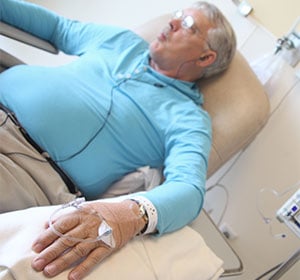Penile Cancer Information

Penile cancer is a relatively uncommon malignancy that develops in the tissues of the penis. In the majority of cases, the cancerous changes originate in skin cells. Therefore, most penile cancers can be classified as a type of skin cancer, such as basal cell carcinoma, squamous cell carcinoma or melanoma.
The precise causes of penile cancer are not yet fully understood within the general medical community. Some experts believe that penile tumors may form after bodily fluids become trapped within the foreskin. As such, men who are uncircumcised or practice poor genital hygiene are believed to have an elevated risk of developing penile cancer, as are men who are older than 50, smoke or have acquired immunodeficiency syndrome (AIDS) or human papillomavirus (HPV). A sexually transmitted infection, HPV has also been linked to an elevated risk of cervical cancer in women.
What are the symptoms of penile cancer?
Early signs of penile cancer are often visible on the foreskin, shaft or head of the penis. Some common symptoms to watch for include:
- A painless lump or thickened area of skin
- An ulcer that doesn’t heal
- A sore that may repeatedly bleed and crust over
- A red, velvety rash
- Small, crusty bumps
- Flat, bluish-brown growths
- Odorous discharge under the foreskin
- Swelling
In addition to penile cancer, most of these symptoms can also result from a less serious bacterial or fungal infection or an allergic reaction. Still, it’s important to promptly discuss any unusual changes with a physician who can provide a proper diagnosis. When detected early, penile cancer can be effectively treated and even cured.
 Usually, penile cancer is diagnosed with a physical exam followed by a biopsy. This procedure involves removing a small amount of suspicious tissue from the penis, then examining the sample under a microscope for evidence of cancer.
Usually, penile cancer is diagnosed with a physical exam followed by a biopsy. This procedure involves removing a small amount of suspicious tissue from the penis, then examining the sample under a microscope for evidence of cancer.
How is penile cancer treated?
For relatively small lesions, surgery is often the recommended treatment approach. By utilizing minimally invasive techniques such as cryosurgery, which freezes and destroys cancerous cells, a surgeon can minimize any disruption to surrounding healthy tissues, which can help to maintain the function and appearance of the penis.
More advanced penile cancer may require more extensive surgery, which may involve removing lymph nodes near the penis, and possibly radiation therapy or chemotherapy.
Moffitt’s approach to penile cancer treatment
Moffitt Cancer Center is proud to have turned the traditional cancer care model on its head. We emphasize rapid care so our patients can begin treatment as soon as possible, which is the key to achieving the best possible outcome and quality of life.
 As a high-volume cancer center, Moffitt sees many patients and treats all forms of male genitourinary cancer, including complex and uncommon malignancies. Nationally recognized for our multispecialty approach, we offer a comprehensive range of treatment options for penile cancer, including traditional surgery, chemotherapy and radiation therapy, as well as innovative cryosurgery and laser therapy.
As a high-volume cancer center, Moffitt sees many patients and treats all forms of male genitourinary cancer, including complex and uncommon malignancies. Nationally recognized for our multispecialty approach, we offer a comprehensive range of treatment options for penile cancer, including traditional surgery, chemotherapy and radiation therapy, as well as innovative cryosurgery and laser therapy.
Our robust clinical trials program
At Moffitt, our patients also have opportunities to participate in groundbreaking clinical trials where they can be among the first to benefit from promising new treatment options that are not yet available elsewhere. Past studies have helped oncologists make several important advances, such as maintaining penile sensation and urinary function after treatment. For our extensive research efforts, Moffitt was named a Comprehensive Cancer Center by the National Cancer Institute.
If you have questions about penile cancer, you can connect with a specialist in the Urologic Oncology Program at Moffitt Cancer Center as soon as possible. Request your appointment by calling 1-888-663-3488 or completing our new patient registration form online.
